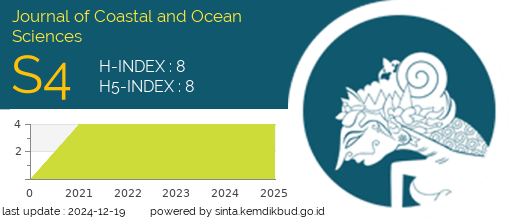Prevalence Analysis of WSSV (White Spot Syndrome Virus) in Vaname Shrimp (Litopenaeus vannamei) in Bengkalis District
DOI:
https://doi.org/10.31258/Keywords:
White shrimp, WSSV, DiseaseAbstract
Vannamei shrimp (Litopenaeus vannamei) is one type of shrimp that is widely cultivated in Indonesia. Vannamei shrimp dominates aquaculture in Indonesia which was previously dominated by tiger shrimp (Penaeus monodon). WSSV, a double-stranded circular DNA virus, has become one of the most widespread and fatal diseases in shrimp populations. Therefore, it is necessary to conduct research to detect the WSSV virus that attacks white vaname shrimp and determine the prevalence rate of the WSSV virus that attacks white vaname shrimp in Bengkalis Regency. This study was conducted from February to June 2022. The purpose of this study was to analyze the prevalence rate of the WSSV virus that attacks white shrimp in the Bengkalis Regency. The research method used in this study is a survey method. The results of the morphological examination did not show any clinical symptoms in vaname shrimp. Tests using PCR with specific primers measuring 941 bp showed DNA bands of vaname shrimp samples from 3 locations, namely Bengkalis district, Bukit Batu district and Rupat district. So the prevalence of the research results obtained is 0%.
Downloads
References
[KKP] Kementerian Kelautan dan Perikanan. (2001). Keputusan Menteri Kelautan dan Perikanan Nomor: KEP. 41/MEN/2001 tentang Pelepasan Varietas Udang Vaname sebagai Varietas Unggul.
Chang, P.S., C. Hsiao-Chao, & W. Yu-Chi. (1998). Detection of white spot syndrome assosiated baculovirus in experimentally infected wild shrimp, crab and lobster by in situ hyridiztion. Aquaculture 164: (233-242).
Elovaara, E.K. (2001). Shrimp Farming Manual:Practical Technology For Intensive Shrimp Production. British West Indies: Carribean Press Ltd.
Fernando, C.F., J.L Furtado., A.V. Gussev., G. Honek., S.A. Kakonge. (1972). Methods for The Study of Freshwater Fish Parasites. University of Waterloo, Canada. Biology Series 12 (2) : 1-44.
Herawati, V.E., Pinandoyo, Darmanto, Y.S., Rismaningsih, N., Hutabarat, J., Prayitno, S.B., and Radjasa, O.K. (2020). Effect of feeding with Phronima sp. on growth, survival rate, and nutrient value content of Pacific white shrimp (Litopenaeus vannamei) Post-larvae. Aquaculture, 735674.
Hulten, M.C.W.V., W. Goldbach, & J.M. Vlak. (2000). Three fungtion diverged major structural proteins of white spot syndrome virus eveloved by gene duplication. J. Gen. Viral., 81: 2,525-2,529.
Knibb, W., Giang, C.T., Premachandra, H.K.A., Ninh, N.H., and Domínguez, B.C. (2019). Feasible options to restore genetic variation in hatchery stocks of the globally important farmed shrimp species, Litopenaeus vannamei. Aquaculture, 734823.
Rodriguez, J., B. Bayot, Y. Amano, Panchana, I. de Blas, V. Alday, & J. Calderon. (2003). White spot syndrome virus infection in culture Penaeus vannamei (Boone) in Ecuador with emphasis on histopathology and ultrastructure. J. Fish Dis., 26: 439-450.
Supriatna, M. (2020). Model pH dan Hubungannya dengan parameter Kualitas Air pada tambak Intensif Udang Vaname (litopenaeus vannamei) di Banyuwangi Jawa Timur. JFMR-Journal of Fisheries and Marine Research, 4(3), 368–374.
Yang, F., Li, X., Li, S., Xiang, J., & Li, F. (2019). A novel cuticle protein involved in WSSV infection to the Pacific white shrimp Litopenaeus vannamei. Developmental and Comparative Immunology, 103491.





